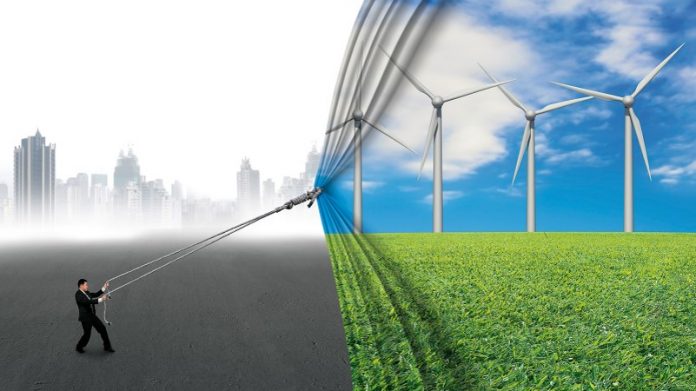The way we get our energy needs has changed dramatically during the last 200 years.
Innovations such as the steam engine, oil lamps, internal combustion engines, and the widespread use of electricity fueled these transformations. The transition from a predominantly agrarian to an industrial global economy necessitated the development of new sources of energy that were more efficient.
The current energy transition is fueled by the knowledge that a reduction in greenhouse gas emissions is required to avoid the catastrophic effects of climate change. Using data from Our World in Data and scientist Vaclav Smil, this infographic provides historical context for the ongoing shift away from fossil fuels.

The First Energy Transition and Coal
People used to heat their homes and cook their food using wood and dried manure, and to grind their grains with muscular power, wind, and water mills before the Industrial Revolution. The use of carts drawn by horses or other animals improved transportation.
Due to scarcity, the price of firewood and charcoal surged throughout the 16th and 17th centuries. As economies evolved and became more sophisticated, these were fueled by rising spending from both people and industries.
As a result, developing economies like the United Kingdom needed a new, less expensive energy source. They switched to coal, signaling the start of the first big energy shift.
| Year | Traditional Biomass % of Energy Mix | Coal % of Energy Mix |
|---|---|---|
| 1800 | 98.3% | 1.7% |
| 1820 | 97.6% | 2.4% |
| 1840 | 95.1% | 4.9% |
| 1860 | 86.8% | 13.3% |
| 1880 | 73.0% | 26.7% |
| 1900 | 50.4% | 47.2% |
| 1920 | 38.4% | 54.4% |
| 1940 | 31.6% | 50.7% |
Because of economies of scale, the cost of generating coal decreased as its use and production rose. At the same time, technical advancements and adaptations ushered in new ways to utilise coal.
Coal was used to heat homes and prepare food, and the steam engine—one of the primary technologies underpinning the Industrial Revolution—was highly reliant on it. The growth of coal’s proportion of the worldwide energy mix, from 1.7 percent in 1800 to 47.2 percent in 1900, demonstrates this.
The Rise of Oil and Gas
Edwin L. Drake drilled the first commercial oil well in Pennsylvania in 1859, but it took nearly a century for oil to become a major source of energy.
Oil was mostly utilized for lighting prior to the huge production of automobiles. After the introduction of assembly lines, oil demand from internal combustion engine vehicles began to rise, and it exploded after World War II as vehicle sales soared.
Similarly, the Bunsen burner revolutionized the way people used natural gas in their homes. Gas became an important source of energy for house heating, cooking, water heaters, and other appliances as pipelines were built.
| Year | Coal % of Energy Mix | Oil % of Energy Mix | Natural Gas % of Energy Mix |
|---|---|---|---|
| 1950 | 44.2% | 19.1% | 7.3% |
| 1960 | 37.0% | 26.6% | 10.7% |
| 1970 | 25.7% | 40.2% | 14.5% |
| 1980 | 23.8% | 40.6% | 16.3% |
| 1990 | 24.4% | 35.5% | 18.4% |
| 2000 | 22.5% | 35.1% | 19.7% |
Coal lost the home heating and transportation markets to gas and electricity, respectively.
Despite this, it grew to become the world’s most important source of power, accounting for more than a third of worldwide electricity output today.
The Rise of Renewable Energy
The ongoing energy transformation is centered on renewable energy sources. Solar and wind energy capacity is growing internationally as countries increase their efforts to reduce emissions.
The following graph shows how the percentage of renewable energy in the global energy mix has changed over the last two decades:
| Year | Traditional Biomass | Renewables | Fossil Fuels | Nuclear Power |
|---|---|---|---|---|
| 2000 | 10.2% | 6.6% | 77.3% | 5.9% |
| 2005 | 8.7% | 6.5% | 79.4% | 5.4% |
| 2010 | 7.7% | 7.7% | 79.9% | 4.7% |
| 2015 | 6.9% | 9.2% | 79.9% | 4.0% |
| 2020 | 6.7% | 11.2% | 78.0% | 4.0% |
Renewable energy’s percentage of total energy increased by only 1.1 percent between 2000 and 2010. However, the rate of growth is picking up; between 2010 and 2020, it was 3.5 percent.
In addition, the current energy shift is unparalleled in terms of both magnitude and speed, with climate targets needing net-zero emissions by 2050. That essentially indicates that fossil fuels will be completely phased out in less than 30 years, with a corresponding rapid increase in renewable energy output.
Following a great year in 2020, renewable energy capacity additions were on track to establish an annual record in 2021. In addition, in 2021, global energy transition investment reached a new high of $755 billion.
However, as history has shown, simply increasing generation capacity is insufficient to help with an energy transition. Mines, canals, and railroads were necessary for coal; wells, pipelines, and refineries were required for oil; and generators and an elaborate system were required for electricity.
Similarly, a complete transition to low-carbon sources necessitates significant investments in natural resources, infrastructure, and grid storage, as well as a shift in human energy consumption habits.
You can also check out :
If you like our content feel free to follow us on Twitter





